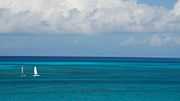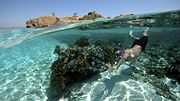East Caicos is the fourth largest island in the Turks and Caicos Islands. To the west, it is separated from Middle Caicos by Lorimer Creek, a narrow passage that can accommodate only small boats. To the south is South Caicos.
Geography
East Caicos belongs to the South Caicos and East Caicos District. has an area of 90.6 km² within the high-water mark, and of 182.0 km² within the shoreline. The difference between the two values is not accounted for as land area. The island is covered by ponds, lakes, swamps and mangroves inhabited by flamingos, wild ducks and pigeons.
The highest point in the Turks and Caicos Archipelago is East Caicos’ Flamingo Hill with an elevation of 156 feet. [1] Savannas stretch across the island’s north side. The north west of the island hosts a cave system that was once used to mine bat guano. Petroglyphs found there are evidence of the island's earliest settlers.[2]
History
Though the island was populated by the Taino Indians 500 years ago and was once the home of a 19th century sisal plantation and a thriving cattle industry, East Caicos Island is currently uninhabited. The cave paintings, the ruins of the town of Jacksonville and abandoned railroad are the only remnants of its former inhabitants. In 2004 a marine archeology expedition found the wreckage of a ship off the island. Both the Enterprize and Trouvadore, illegal Spanish slavers, had gone down in this area, in 1837 and 1841, respectively. One hundred-ninety-two captive Africans survived the Trouvadore sinking and were helped by British colonists to resettle as free persons, mostly on Grand Turk Island, with 24 taken to Nassau.[3]
Images
| Flamingos on North Caicos |
| Snorkeling off North Caicos |
| Conch Caught off North Caicos |
| The Beaches of North Caicos |
|
External links
- | Turks and Caicos Islands Directory - East Caicos
References
Coordinates: 21°42′09″N 71°29′53″W / 21.70250°N 71.49806°W / 21.70250; -71.49806





